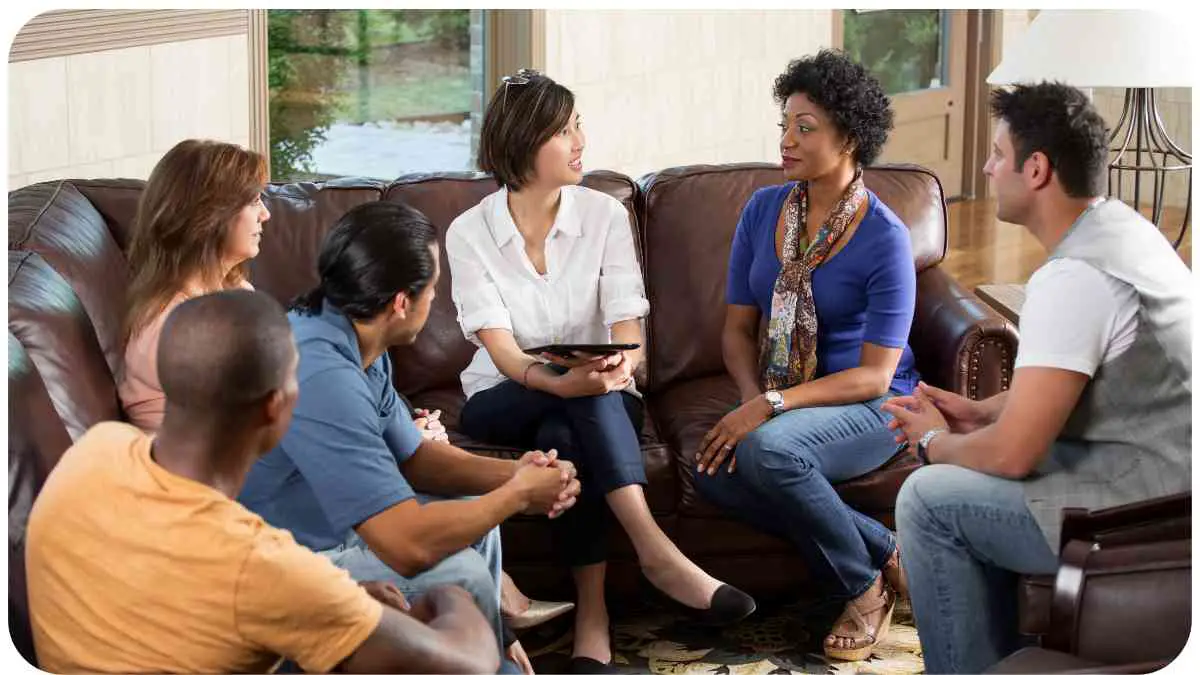Losing a loved one is an incredibly difficult experience, and navigating the grief that follows can be challenging. Local grief support groups provide a valuable resource for individuals who are grieving by offering a safe and understanding community.
In this step-by-step guide, we will explore the process of starting a local grief support group, highlighting the importance of experience, expertise, authoritativeness, and trust in creating a supportive environment.
| Takeaways |
|---|
| Understand the purpose and need for a grief support group in your community. |
| Recruit qualified leaders who have the necessary skills and empathy to facilitate a support group effectively. |
| Determine the logistics of the group, including meeting frequency, location, and duration. |
| Establish clear ground rules and guidelines to create a safe and respectful environment for group members. |
| Use various marketing strategies to promote your support group and reach individuals in need of support. |
| Follow a structured agenda during meetings to ensure a productive and beneficial experience for members. |
| Provide relevant resources and educational materials to support members’ healing and growth. |
| Regularly evaluate the effectiveness of the group and gather feedback from participants to make improvements. |
| Seek additional training and professional development opportunities to enhance your skills as a support group leader. |
Understanding the Importance of Grief Support Groups
Grief support groups play a vital role in helping individuals cope with the loss of a loved one. These groups offer a non-judgmental space where people can share their experiences, emotions, and challenges with others who have gone through similar situations.
Dealing with grief alone can be overwhelming, but you don’t have to go through it by yourself. Discover the importance of building a support system after a loss, and how finding strength in community can make a big difference in your healing journey.
Benefits of Grief Support Groups
The following benefits highlight the significance of grief support groups:
- Emotional Support: Grief support groups provide a safe space for individuals to express their emotions and receive empathy from others who understand their pain.
- Validation: Being part of a grief support group reassures individuals that their feelings and experiences are normal, validating their grief journey.
- Shared Experiences: Interacting with others who have faced similar losses allows individuals to learn from different perspectives, gain insights, and realize they are not alone in their grief.
- Coping Skills: Support groups often provide coping strategies and resources to help individuals navigate the grieving process and rebuild their lives.
- Community: Membership in a support group establishes a sense of belonging and fosters connections, reducing feelings of isolation and loneliness.
Step 1: Clarify your Purpose

Before starting a local grief support group, it’s important to define your purpose for creating the group. Clarifying your objectives will help guide your decisions throughout the process.
Table: Purpose of the Support Group
| Objective | Description |
| Provide Emotional Support | Create a safe space where individuals can express their emotions and find support from others. |
| Share Knowledge and Resources | Share information and resources about grief, coping mechanisms, and available support services. |
| Foster Connection | Facilitate a sense of community and connection among group members who share similar experiences. |
By clearly defining your purpose, you can ensure that your support group addresses the specific needs of your target audience.
During times of grief, a strong support system can be a lifeline. Learn more about the power of having a support system and how it can help you navigate through challenging times of loss in our guide on the power of a support system.
Step 2: Identify Target Audience
Understanding your target audience is essential to provide tailored support and meet their unique needs. Consider demographics such as age, relationship to the deceased, and any specific challenges they may face.
Table: Target Audience Demographics
| Demographic | Description |
| Age Range | Identify the age group most likely to benefit from the support group. |
| Loss Type | Determine the specific types of losses the support group will address (e.g., spousal loss). |
| Relationship | Identify the relationship the target audience has with the deceased (e.g., parent, sibling). |
| Special Needs | Note any considerations for individuals with specific needs or circumstances. |
Identifying your target audience will guide your decision-making process, ensuring your support group caters to their specific requirements.
Step 3: Recruit Support Group Leaders
Support group leaders play a crucial role in facilitating discussions, providing guidance, and creating a safe environment. Look for individuals with a background in counseling, social work, or relevant experience in supporting those who are grieving.
Table: Potential Support Group Leaders (Continued)
| Name | Qualifications | Experience |
| Emily Davis | Social Worker and Grief Specialist | Worked with various grief support organizations. |
| Michael Lee | Psychologist | Published articles on grief and trauma in professional journals. |
By carefully selecting qualified leaders with relevant experience, you can ensure the support group is led by knowledgeable individuals who can guide members through their grief journey.
Step 4: Determine Meeting Logistics
Establishing the logistics of your support group meetings is crucial for creating a consistent and welcoming environment. Consider factors such as the meeting location, frequency, duration, and any additional resources required.
Table: Meeting Logistics Checklist
| Meeting Aspect | Considerations |
| Location | Find a quiet and accessible space, such as a community center or local library. |
| Frequency | Determine the meeting schedule, whether it be weekly, biweekly, or monthly. |
| Duration | Decide on the meeting duration, typically ranging from 1-2 hours. |
| Guest Speakers | Consider inviting guest speakers, such as grief counselors or therapists, to provide additional expertise and support. |
| Materials Needed | Prepare any necessary materials, such as tissues, handouts, or books about grief and coping. |
By addressing meeting logistics, you can ensure that your support group is well-organized and accommodating for attendees.
Table: Meeting Logistics Checklist (Continued)
| Meeting Aspect | Considerations |
| Refreshments | Determine if refreshments will be provided, such as coffee, tea, or snacks, to create a welcoming atmosphere. |
| Accessibility | Ensure that the meeting location is accessible for individuals with disabilities or mobility issues. |
| Privacy | Promote a confidential and safe space where members can freely share their thoughts and emotions without judgment. |
| Seating Arrangement | Arrange seating in a circular or semi-circle format to encourage interaction and a sense of community among participants. |
| Meeting Reminders | Develop a system to send out reminders to members about upcoming meetings, either through email or other communication channels. |
Considering these meeting logistics will help you create an environment that fosters trust, connection, and comfort for your support group members.
Are you looking for ways to cope with grief and loss? Building a support system is essential. Explore our comprehensive guide on 10 ways to build a support system for grief and loss to discover practical strategies that can provide comfort and solace during difficult times.
Step 5: Establish Ground Rules and Group Guidelines

Clearly outlining ground rules and group guidelines is essential for maintaining a respectful and supportive atmosphere within your grief support group. These guidelines will help set expectations and ensure everyone feels safe and comfortable sharing their experiences.
Table: Sample Ground Rules and Guidelines
| Ground Rules | Guidelines |
| Respect and Confidentiality | Emphasize the importance of respecting each other’s privacy and maintaining confidentiality in group discussions. |
| Active Listening | Encourage active listening, allowing each member to share their thoughts and feelings without interruption or judgment. |
| Non-Judgmental Attitude | Foster an environment free of judgment, where members can express themselves honestly without fear of criticism or negativity. |
| Mutual Support | Promote mutual support and empathy among members, encouraging everyone to contribute positively to each other’s well-being. |
| Professional Boundaries | Establish clear boundaries between group members and support group leaders, maintaining a professional and ethical environment. |
By establishing these ground rules and group guidelines, you can facilitate a safe and nurturing atmosphere for open and honest communication.
Table: Sample Ground Rules and Guidelines (Continued)
| Ground Rules | Guidelines |
| Time Management | Encourage members to be punctual and respect the designated meeting time, ensuring that all participants have an equal opportunity to share. |
| One Person Speaks at a Time | Promote respectful communication by allowing only one person to speak at a time, ensuring that everyone’s voice is heard. |
| Confidentiality within Limits | Remind members that while confidentiality is important, there may be situations where ethical boundaries require sharing information outside the group, such as the risk of harm to oneself or others. |
| Referral Assistance | Provide information about professional resources and referrals for individuals who may require additional support beyond the group setting. |
| Positive Environment | Encourage a positive and uplifting atmosphere, where members support and encourage one another’s growth and healing throughout their grief journey. |
Establishing clear ground rules and group guidelines is vital for a cohesive and respectful support group experience. These guidelines will help create a space where everyone feels comfortable opening up and sharing their grief.
Step 6: Promote and Market the Support Group
In order to reach individuals who may benefit from your grief support group, it’s essential to develop effective marketing strategies. By promoting your support group, you can raise awareness and attract individuals in need of support.
Coping with grief alone can be isolating, but you don’t have to face it without support. Learn effective ways to build a support system to lean on during your grieving process and find the strength to heal and recover.
Table: Marketing Strategies
| Marketing Strategy | Description |
| Online Presence | Create a dedicated website or social media profiles to promote the support group and provide information about meeting schedules and contact details. |
| Local Community | Reach out to local organizations, such as funeral homes, hospices, counseling centers, and religious institutions, to share information about the support group. |
| Word of Mouth | Encourage current group members to spread the word and bring friends or family members who may benefit from the support group. |
| Flyers and Posters | Design eye-catching flyers and posters to display in community centers, libraries, coffee shops, and other public spaces. |
| Newspaper Advertisements | Place advertisements in local newspapers or community newsletters to reach a broader audience. |
By implementing these marketing strategies, you can effectively promote your grief support group and reach those who may be seeking support in their grief journey.
Table: Marketing Strategies (Continued)
| Marketing Strategy | Description |
| Online Groups and Forums | Join online grief support groups and forums to connect with individuals who are actively seeking support, and share information about your local support group. |
| Collaboration with Related Organizations | Collaborate with other organizations, such as mental health centers, hospitals, or bereavement groups, to reach a wider audience and expand the support network. |
| Local Media Coverage | Reach out to local newspapers, radio stations, or television channels to share your support group’s mission and offerings, and request media coverage or interviews. |
| Community Events | Participate in community events or health fairs to create awareness about your support group, distribute flyers, and engage with individuals who may be interested. |
| Online Advertising | Consider running targeted online advertisements on platforms like Google Ads or social media channels to reach individuals searching for grief support resources. |
Implementing a combination of these marketing strategies will help you effectively market your local grief support group, ensuring that individuals who can benefit from your services are aware of and have access to the support you provide.
Step 7: Conduct Effective Meetings
Running effective support group meetings is essential to provide a nurturing environment for members to share their experiences, find support, and learn coping strategies. By following a structured agenda, you can create a meaningful and productive atmosphere.
Table: Meeting Agenda Template
| Time | Agenda Item |
| 10 mins | Welcome and Introduction |
| 15 mins | Icebreaker Activity |
| 30 mins | Open Sharing and Discussion |
| 20 mins | Guest Speaker or Topic Presentation |
| 20 mins | Group Activity or Exercise |
| 15 mins | Resource Sharing and Q&A |
| 10 mins | Reflection and Closing Remarks |
Following an agenda with a variety of activities and discussion topics allows for member engagement and ensures that each meeting provides valuable support and learning opportunities.
After experiencing a loss, creating a supportive network can be a crucial step in your healing journey. Our guide on creating a supportive network after a loss offers valuable tips and strategies to help you establish meaningful connections that can provide comfort and understanding in times of grief.
Table: Meeting Agenda Template (Continued)
| Time | Agenda Item |
| 10 mins | Review and Recap of Previous Meeting |
| 30 mins | Member Sharing and Check-in |
| 20 mins | Educational Presentation or Workshop |
| 20 mins | Group Discussion or Small Group Activities |
| 15 mins | Coping Techniques or Skill-Building Exercise |
| 15 mins | Resource Recommendations and Closing Remarks |
By structuring your meetings using this agenda template, you can ensure that each session provides a balance of emotional support, educational content, and interactive activities to foster healing and growth within the group.
Step 8: Provide Resources and Educational Materials

Support group members often benefit from access to relevant resources and educational materials that can help them better understand and cope with their grief. By providing these materials, you can further support their healing journey.
Table: Recommended Resources
| Resource Type | Description |
| Books | Recommend books on grief, loss, and coping strategies that members can borrow or purchase. |
| Websites and Blogs | Share links to reputable websites and blogs that provide information and support for grief. |
| Support Services | Provide a list of local support services, such as counseling centers, therapists, and helplines. |
| Community Programs | Inform members about community programs or workshops focused on grief and healing. |
| Self-Care Tips | Offer self-care tips and techniques to help members take care of their emotional well-being. |
By equipping support group members with these resources, you empower them to continue their healing process outside of the group setting.
Table: Recommended Resources (Continued)
| Resource Type | Description |
| Online Support Groups | Provide information about online grief support groups, forums, or chatrooms for additional support and connection. |
| Meditation and Mindfulness Apps | Recommend meditation and mindfulness apps that can help members manage stress and emotions during their grief journey. |
| Podcasts | Suggest grief-related podcasts that offer insights, personal stories, and coping strategies for listeners. |
| Therapeutic Activities | Share ideas for therapeutic activities, such as journaling prompts, art therapy exercises, or nature walks, that can promote healing and self-expression. |
| Online Courses | Recommend online courses or webinars focused on grief and loss, providing members with opportunities for further education and growth. |
Providing comprehensive resources and educational materials will enhance the support provided by your group, giving members a variety of tools and options to navigate their grief.
Step 9: Evaluation and Feedback
Regularly evaluating the effectiveness of your support group and seeking feedback from members is vital for continuous improvement. This will help you identify strengths, areas for improvement, and ensure that the needs of your members are being met.
Table: Evaluation and Feedback
| Evaluation Aspect | Considerations |
| Participant Feedback | Provide regular opportunities for members to share their feedback on the support group structure, format, and content. |
| Group Facilitator Evaluation | Seek input from group facilitators to assess their experience leading the support group and identify any challenges or training needs. |
| Outcome Assessment | Conduct periodic assessments to measure the impact and effectiveness of the support group on members’ well-being and grief recovery process. |
| Reflection and Adaptation | Reflect on the evaluation results and feedback received to make necessary adjustments and improvements to the support group as needed. |
By actively seeking feedback and evaluating the effectiveness of your support group, you can ensure its continuous growth and adaptability to better meet the needs of your members.
Table: Evaluation and Feedback (Continued)
| Evaluation Aspect | Considerations |
| Attendance and Retention Rates | Track attendance and member retention rates to assess the level of engagement and satisfaction with the support group. |
| Qualitative Feedback | Encourage members to share their experiences, personal growth, and changes they have experienced as a result of participating in the support group. |
| Surveys or Questionnaires | Create surveys or questionnaires to gather anonymous feedback on various aspects of the support group, such as meeting content, facilitation, and overall satisfaction. |
| Group Facilitator Support | Provide ongoing support and supervision for group facilitators to address any challenges or difficulties they may encounter in leading the group effectively. |
| Continuous Improvement | Use the evaluation and feedback to make continuous improvements to the support group, including adjustments to meeting structure, resources, or topics of discussion. |
By utilizing these evaluation and feedback strategies, you can gather valuable insights and make informed decisions to enhance the quality and effectiveness of your grief support group.
Step 10: Seek Additional Training and Professional Development
Continuing your own professional growth and education in grief support is essential to provide the best possible care for your support group members. Seek additional training and development opportunities to enhance your knowledge and skills as a support group leader.
Consider the following training and professional development options:
- Attend grief support workshops or seminars.
- Pursue certifications or advanced degrees in grief counseling or related fields.
- Join professional organizations or associations for grief support.
- Engage in ongoing self-study through books, research articles, and online resources.
Investing in your own growth as a support group leader will not only benefit your members but also ensure you stay up-to-date with best practices in grief support.
Conclusion
In conclusion, establishing and running a grief support group requires careful planning, organization, and dedication. By following the steps outlined in this guide, you can create a nurturing and supportive environment where individuals can find solace, understanding, and healing in their grief journey.
Starting with identifying the need in your community, recruiting qualified leaders, determining meeting logistics, and establishing ground rules, you lay the foundation for a successful support group.
Promoting the group, conducting effective meetings, providing resources and educational materials, and seeking regular evaluation and feedback ensure continuous improvement and the best support for group members.
Lastly, investing in your own professional development ensures that you, as a support group leader, are equipped with the knowledge and skills needed to guide and empower your members. With these steps, you can make a meaningful difference in the lives of those experiencing grief, offering them a safe space to share, heal, and find hope.
Further Reading
Here are some additional resources that provide further guidance and information on starting and running a grief support group:
Running a Grief Group Toolkit: This toolkit provides practical tips and tools for organizing and facilitating a grief support group. It covers various aspects, including group dynamics, meeting formats, and participant engagement.
How to Start a Grief Support Group: This article offers a step-by-step guide on initiating a grief support group. It explores important considerations such as defining the purpose, finding a suitable location, and reaching out to potential members.
Sample Grief Group Session: This resource provides an example of a structured grief group session. It includes a sample agenda and discussion topics to give you an idea of how to structure your meetings and facilitate meaningful discussions.
FAQs
What are the benefits of joining a grief support group?
Grief support groups provide a safe and understanding environment where individuals can share their thoughts and emotions, receive support from others who have experienced similar losses, gain coping strategies, and feel less alone in their grief journey.
How long do grief support groups typically last?
The duration of grief support groups can vary. Some groups may have a set number of sessions, while others may be ongoing and meet regularly for an extended period. It depends on the specific structure and goals of the support group.
Do I have to share my personal experiences in a grief support group?
Sharing personal experiences in a grief support group is voluntary. Members can choose to share as much or as little as they feel comfortable with. The group is a non-judgmental space where individuals are respected for their own pace of healing.
Are grief support groups only for recent losses?
Grief support groups welcome individuals at any stage of their grief journey, regardless of when the loss occurred. Whether it’s a recent loss or one that happened years ago, grief support groups offer understanding and support to all participants.
How can I find a grief support group near me?
To find a grief support group in your area, consider reaching out to local hospices, counseling centers, religious organizations, or bereavement groups. They can provide information on available support groups or refer you to relevant resources.

My name is Hellen James. I’m a grief and loss recovery expert who has helped people across the country to move beyond their grief and move forward with their lives.


